Table of Contents
Introduction
According to Bitcoin Statistics, Bitcoin, often called “digital gold” or a “cryptocurrency,” emerged in 2009, created by an enigmatic individual known as Satoshi Nakamoto. It functions on a decentralized blockchain network, notable for its capped supply of 21 million coins, establishing it as a deflationary asset. Bitcoin enables direct peer-to-peer transactions without intermediaries, employing robust cryptographic security measures.
It has garnered recognition as a digital store of value and a medium of exchange, attracting investments and offering potential solutions for remittances and financial inclusivity. Despite encountering obstacles like regulatory scrutiny and scalability concerns, Bitcoin’s continual development is disrupting conventional financial systems, and its enduring influence on the worldwide economy remains a topic of profound interest and pioneering advancements.
Editor’s Choice
- Bitcoin market capitalization hovers around $850 billion, while the network handles over 400,000 daily transactions.
- Approximately 100 million individuals worldwide are holders, and the number of distinct Bitcoin addresses exceeds 900 million.
- More than 65% of these addresses hold less than 0.001 BTC. The cryptocurrency landscape is vast, encompassing over 6,000 unique digital currencies.
- Bitcoin enjoys frequent mentions on social media platforms, averaging one reference every 3 seconds.
- Projections suggest that the global blockchain market will grow to $23.3 billion by 2023.
- Approximately 46,000 nodes across the globe uphold the network.
- In terms of energy consumption, Bitcoin utilizes approximately 112 terawatt-hours per year, which aligns with Argentina’s energy usage.
- The Winklevoss twins are estimated to possess 1% of the total supply.
Bitcoin Market Capitalization
Current Market Cap of Bitcoin
- As of October 26, 2023, Its market capitalization is currently valued at USD 665.96 billion, and the 24-hour trading volume amounts to USD 19.27 billion.
- The price of BTC in USD is continuously updated in real-time.
- It has a circulating supply of 19.52 million units.
Historical Trends in Market Cap
- The market capitalization (BTC) has exhibited remarkable growth and fluctuations over time.
- In April 2016, it stood at a relatively modest USD 6.94 billion, but by July 2017, it had surged to USD 47.39 billion, signifying its increasing popularity.
- The year 2021 was particularly noteworthy, with April marking a milestone as it crossed the trillion-dollar threshold at USD 1079.67 billion and reached USD 1156.49 billion by October.
- However, the market cap dipped to USD 865.2 billion in March 2022, illustrating its volatility.
- As of February 2023, it stands at USD 446.85 billion, with fluctuations expected to continue as Bitcoin remains a dynamic and influential cryptocurrency player.

Price Performance of Bitcoin
Current Price of Bitcoin
- The current price of Bitcoin stands at $34,108.07 per BTC when traded against the US dollar (BTC/USD).
- Over the past few months, has experienced a decrease of 1.85% in its value.
Historical Price Chart and Trends
- The price of Bitcoin (BTC) has seen significant fluctuations over the years.
- In April 2016, it was valued at USD 451.82 per BTC, showing the relatively modest beginnings of this cryptocurrency.
- However, by March 2022, it had decreased to USD 44510.8.
- Further, October 2022 witnessed a notable drop to USD 20800.7.
- As of January 2023, Bitcoin is priced at USD 16950.8, highlighting the cryptocurrency market’s price volatility.
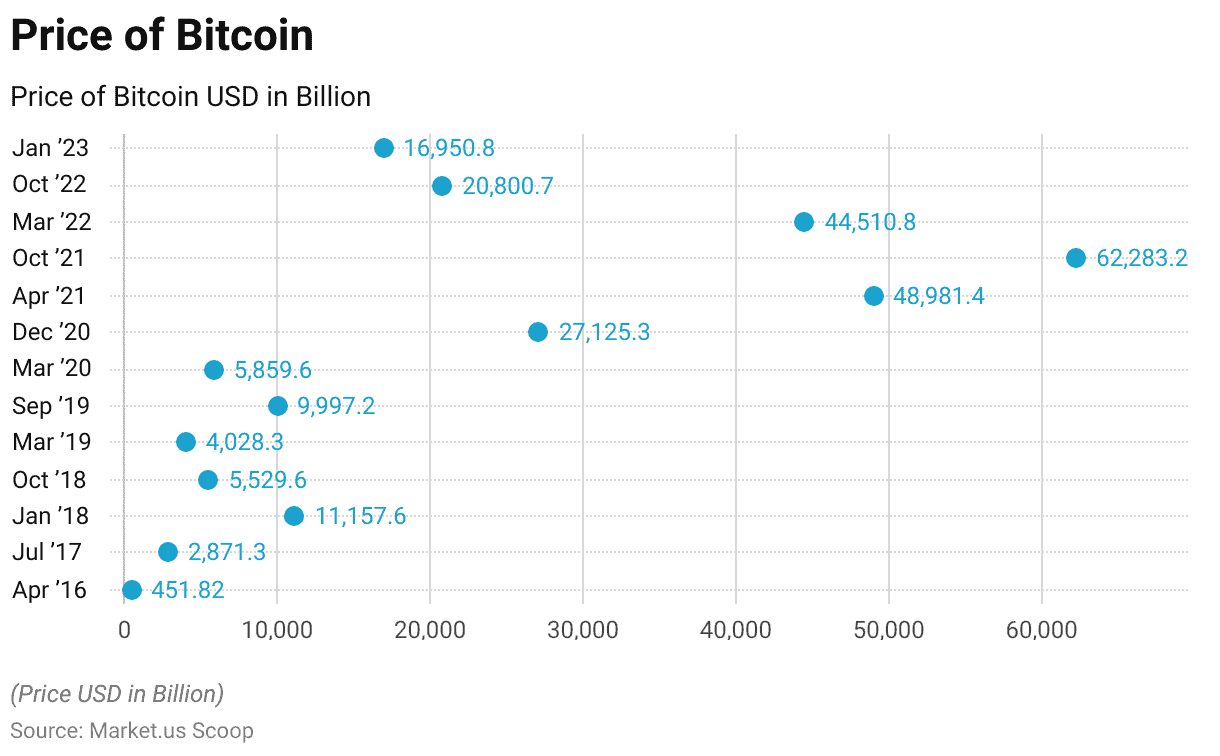
Bitcoin Trading Volume
Daily Trading Volume of Bitcoin
- The daily trading volume of Bitcoin (BTC) has witnessed significant fluctuations over time.
- On March 27, 2017, it stood at a relatively modest USD 0.3 billion, reflecting the earlier stages of the cryptocurrency market.
- As of January 30, 2023, the daily trading volume stands at USD 24.7 billion, highlighting the dynamic nature of the cryptocurrency market.
- Looking ahead, October 23, 2023, recorded a trading volume of USD 32.5 billion, indicating continued interest and activity in trading.
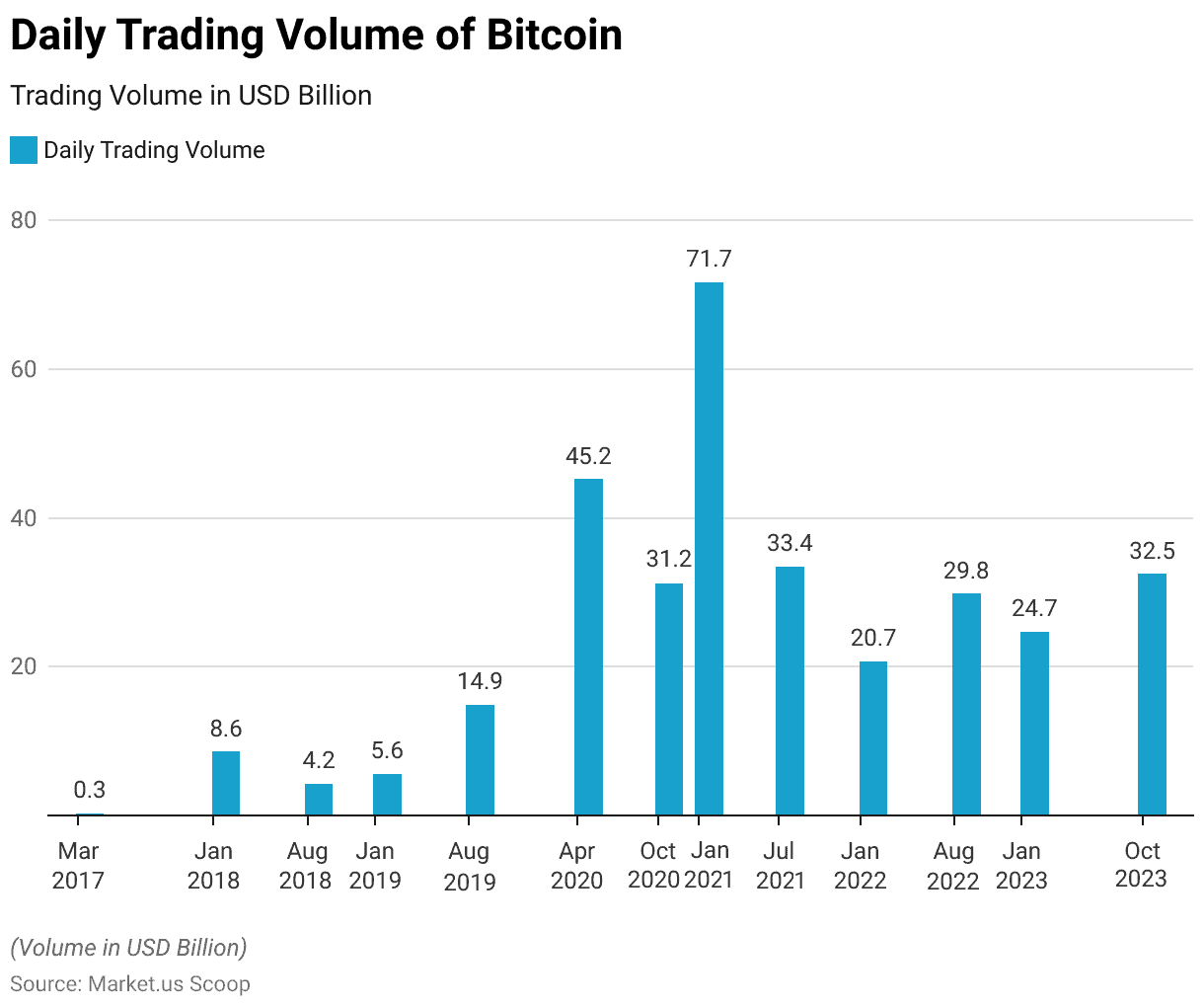
Bitcoin Transactions per Day
- The metric of Bitcoin transactions per day serves as an indicator of the network’s transaction volume.
- The blockchain functions as a transparent ledger, documenting all transactions within blocks generated approximately every 10 minutes.
- This metric is anticipated to increase as cryptocurrency gains broader adoption, resulting in elevated transaction levels and increased user participation.
- Bitcoin processes around 400,000 transactions per day, showing its scalability.
Exchange-Wise Volume Distribution
- The distribution of Bitcoin trading volume across various exchanges reveals interesting insights into the cryptocurrency market.
- Among these exchanges, Coinbase stands out as a dominant player, accounting for 65.56% of the total volume, with a trading volume of 439 thousand.
- Following closely behind is Kraken, with 13.60% of the market share and a trading volume of 91000.
- Bitstamp and Bitfinex also contribute significantly, with 9.63% and 7.57% market shares, respectively, and trading volumes of 64.4 thousand and 50.7 thousand.
- The Gemini exchange holds a 2.17% market share with a trading volume of 14.5 thousand.
- In contrast, smaller exchanges like Exmo, BTCMarkets, Korbit, and Bitcoin.co.id have market shares ranging from 0.14% to 0.79%, indicating a more limited presence in the market.
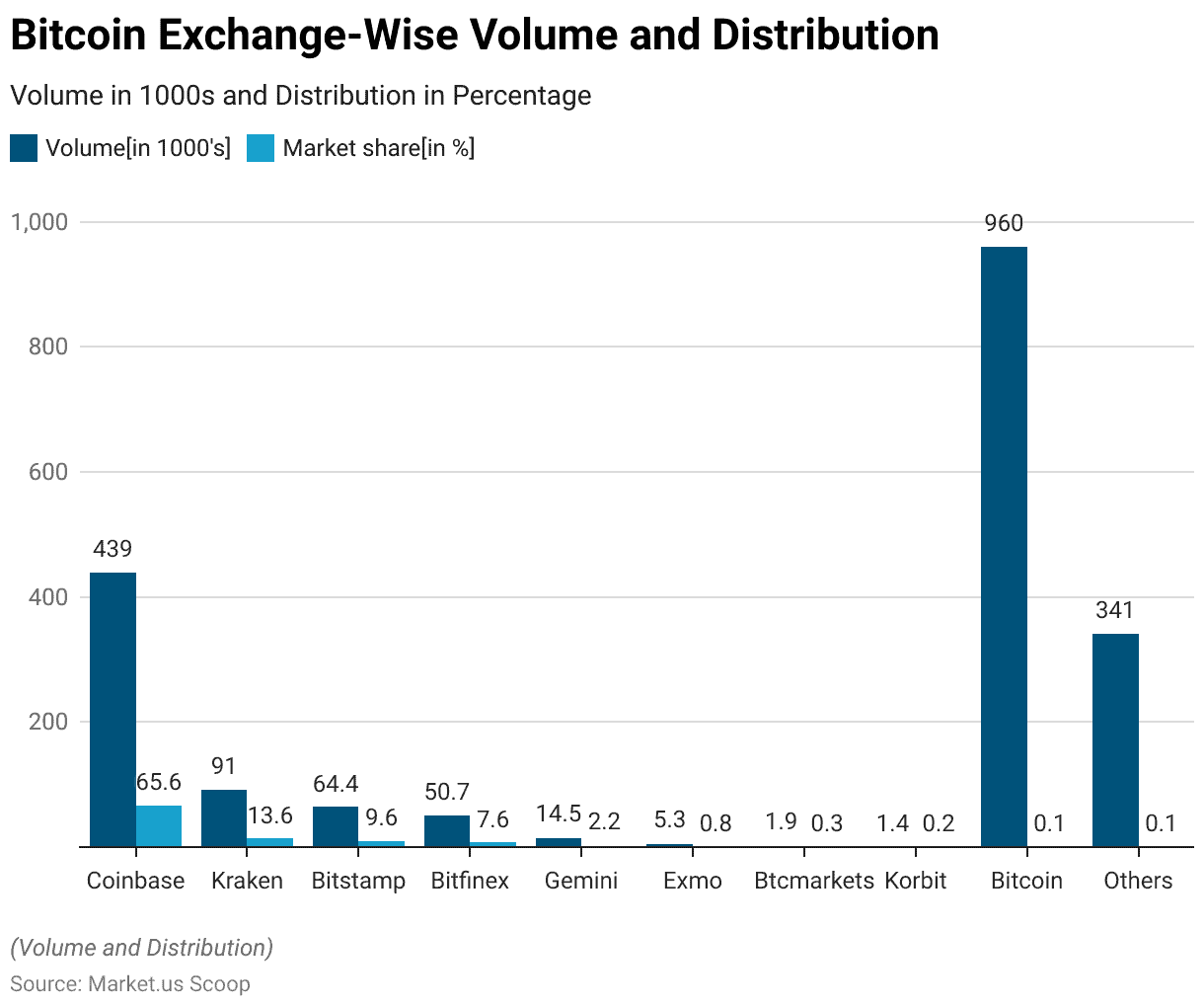
Bitcoin Network Hash rate
Recent Trends in Bitcoin’s Hash Rate
- The Bitcoin hash rate reflects the network’s computational power and has displayed notable fluctuations over the specified period.
- As of October 3, 2022, the hash rate stood at 238.84 EH/s (exahashes per second).
- By September 26, 2023, it stood at 392.33 EH/s, with fluctuations continuing.
- On October 26, 2023, the hash rate reached 486.49 EH/s, underlining the dynamic nature of Bitcoin’s computational power and the ongoing competition among miners to secure the network.

Demographics of Bitcoin Users
According to Age
- As per a survey, European Bitcoin users are distributed across various age groups, reflecting the diverse appeal of the cryptocurrency.
- The age group of 25-34 years comprises the largest segment, with 38.2% of users falling within this range.
- The 35-44 age group follows closely, representing 25.5% of users, indicating a significant presence in the mid-age bracket.
- Those aged 18-24 constitute 15.3% of users, while the 45-54 age group makes up 13.1%.
- Users aged 55-64 account for 5.6% of the total, and the 65+ age group forms a smaller yet notable portion, contributing 2.3% of users.
- About 55% of Americans aged 18-34 plan to buy Bitcoin by 2025, showing increased interest in younger generations.

According to Gender
- 16% of men and 7% of women are involved with cryptocurrency.
- In the world of users, there exists a significant gender disparity, with males dominating the landscape, constituting a substantial 86.9% of the user base.
- Conversely, female representation in the Bitcoin community remains notably lower, accounting for 13.1% of the total user population.
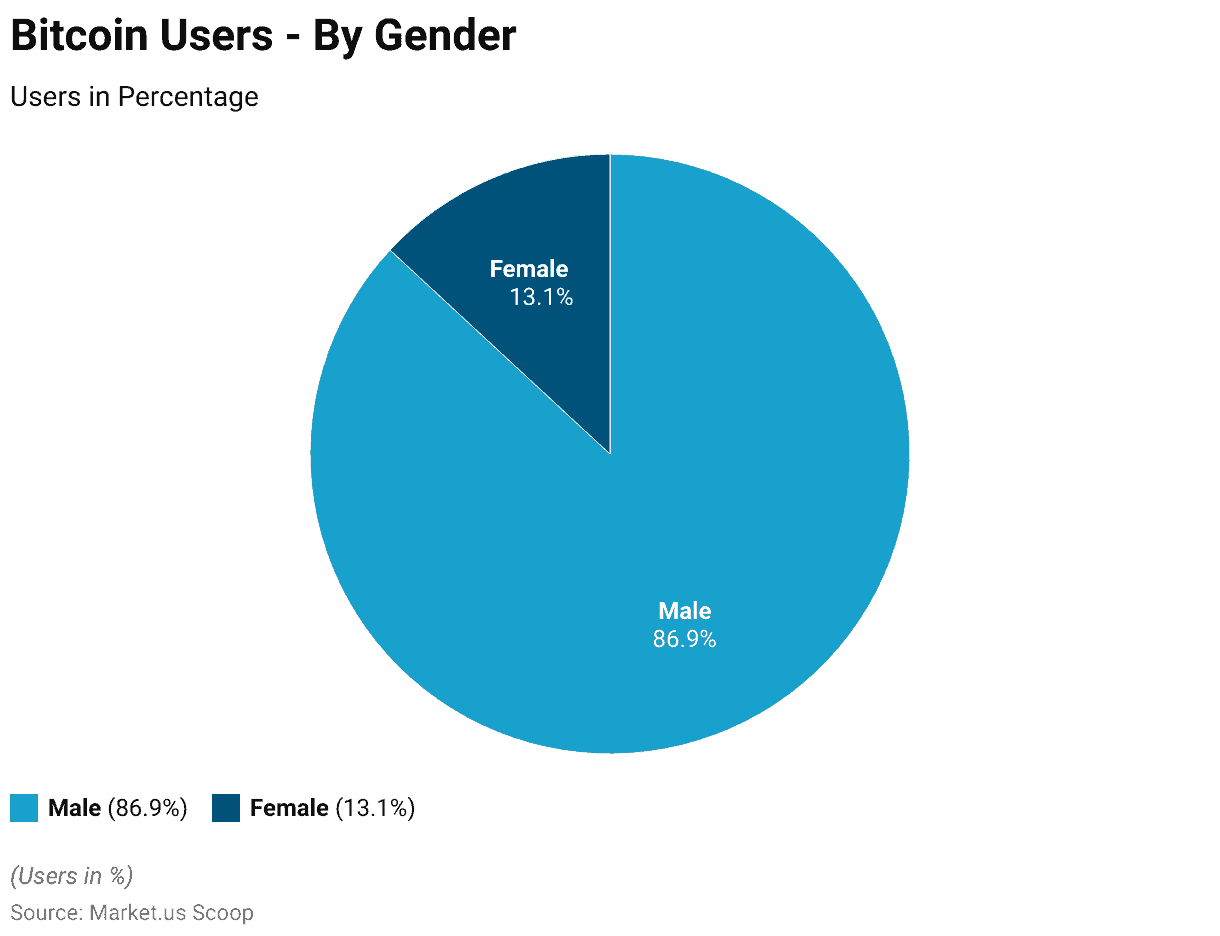
Bitcoin Regional Statistics
- Crypto and Bitcoin users are distributed across various regions, reflecting the global nature of digital currencies.
- Asia emerged as a dominant player in the cryptocurrency landscape, with a substantial 160 million users, highlighting its significant adoption and interest in the digital currency space.
- Europe follows with 38 million users, showing a notable presence in the continent.
- North America and Africa contribute considerably, with 28 million and 32 million users, respectively, while South America accounts for 24 million.
- Oceania, on the other hand, registers a smaller user base, with 1 million users.
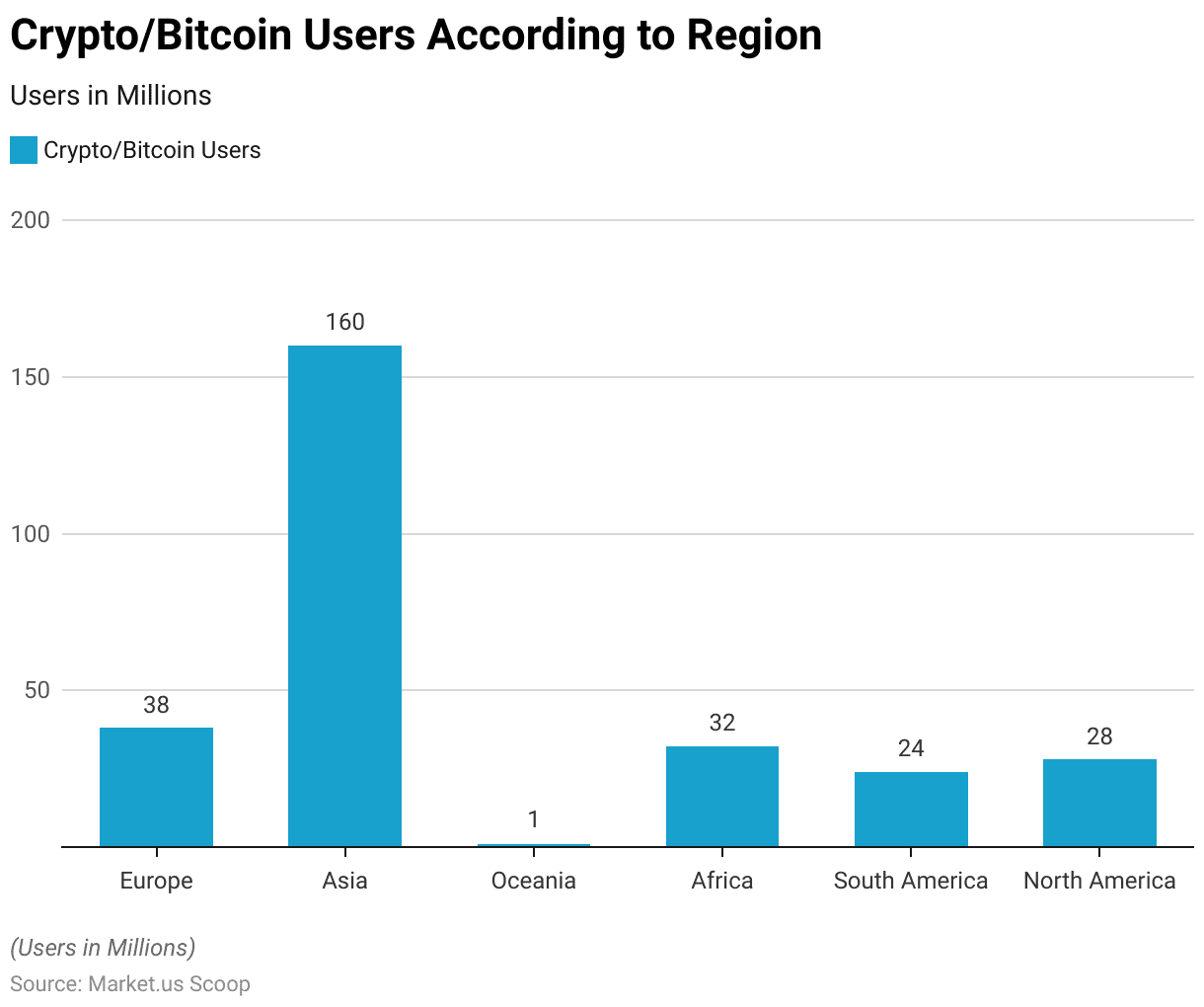
Top Countries with the Most Crypto/ Bitcoin Owners
- Cryptocurrency and Bitcoin users are dispersed across different countries, reflecting the global nature of digital currencies.
- India stands out as a prominent player in the cryptocurrency space, boasting a substantial user base of 100 million individuals.
- The United States, a significant hub for cryptocurrency innovation, follows with 30 million users.
- Russia and Nigeria also make notable contributions, with 18 million and 16 million users, respectively.
- Brazil is another country showing a strong interest in digital currencies, with 15 million users.
- Ukraine rounds out the list with 10 million users.
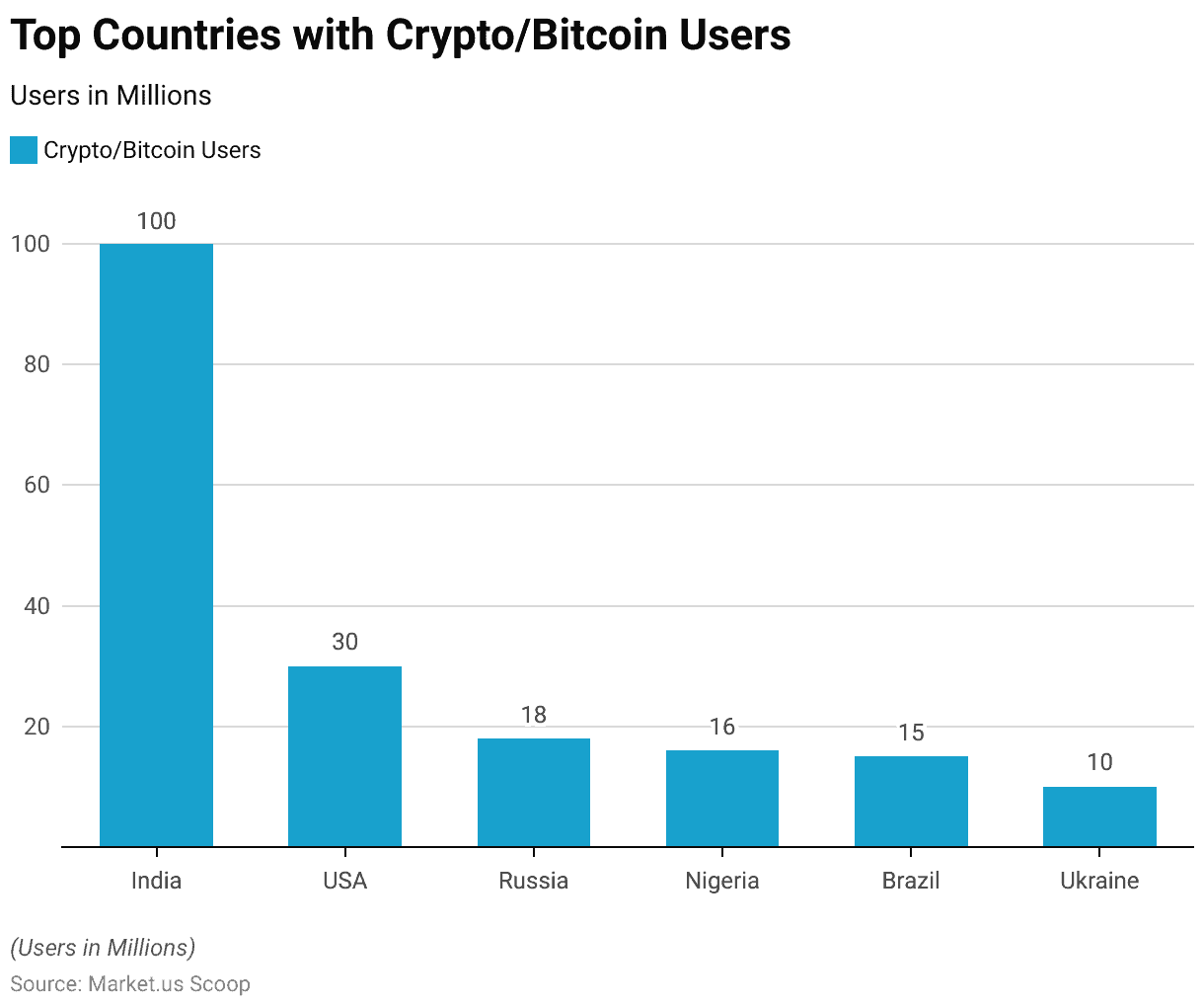
Biggest Public Companies with Bitcoin
- MicroStrategy holds over 129,000 BTC.
- Tesla and Coinbase made headlines for their investments.
- Marathon Digital aims to have over 199,000 miners by 2023.
Bitcoin Mining Statistics
- Bitcoin mining consumes significant electricity, about 0.40% of the world’s total consumption.
- Bitcoin mining generates carbon emissions comparable to Sri Lanka’s.
- A single transaction’s carbon footprint equals over 497,000 Visa transactions.
- Bitcoin’s energy consumption is equivalent to Argentina’s electricity usage.


